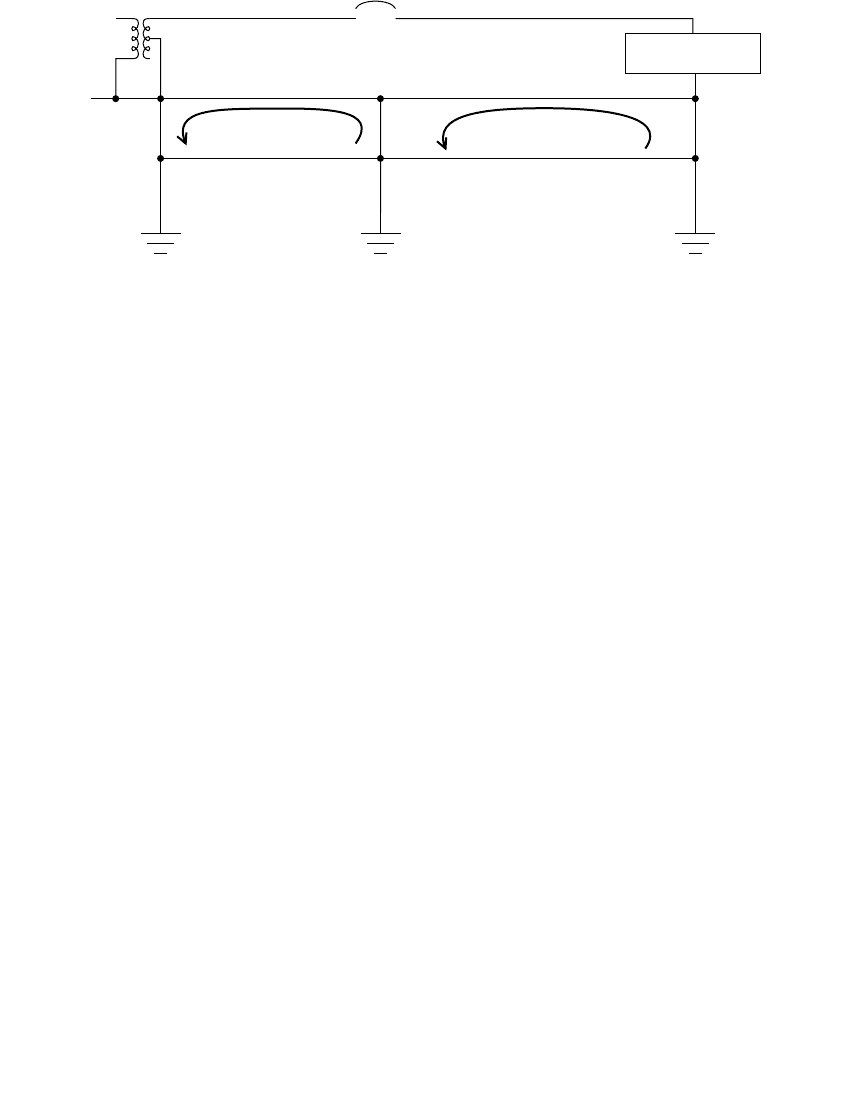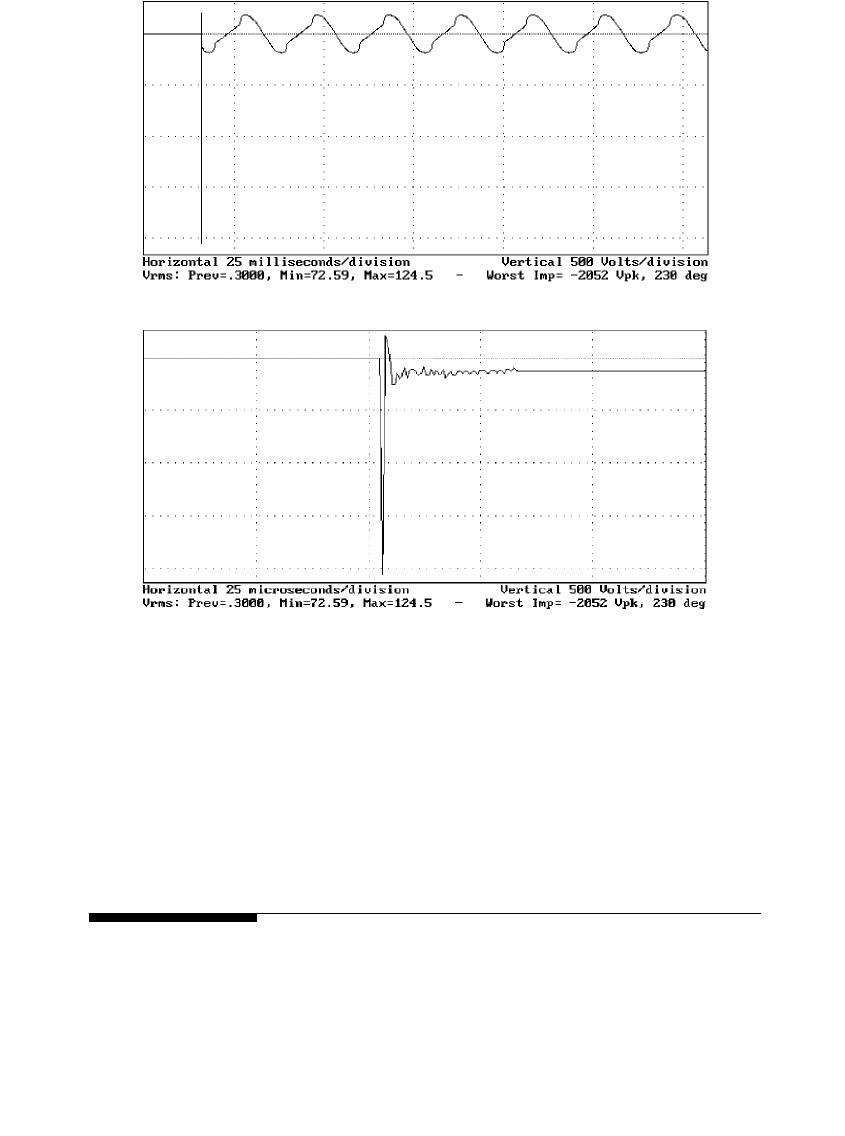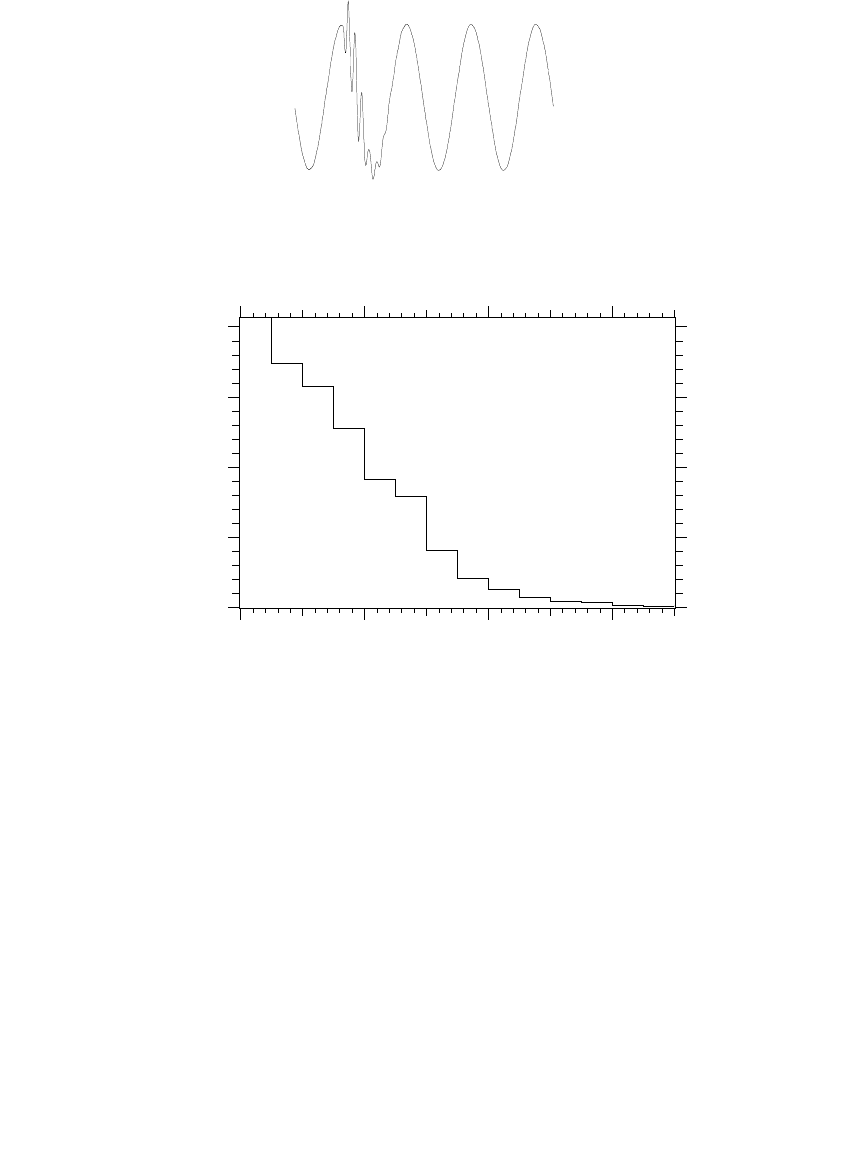Short T.A. Electric Power Distribution Handbook
Подождите немного. Документ загружается.


Voltage Sags and Momentary Interruptions 537
All I know is that when shit hits the fan, management calls us we don’t call them.
In response to: Do linemen feel they are respected by management and
coworkers for the jobs they are doing, do management and coworkers
understand what you do?
www.powerlineman.com
1791_book.fm Page 537 Monday, August 4, 2003 3:20 PM
(C) 2004 by CRC Press LLC

11
Other Power Quality Issues
While voltage sags and momentary interruptions cause the most widespread
power quality problems, several other power quality disturbances can dam-
age equipment, overheat equipment, disrupt processes, cause data loss, and
annoy and upset customers. In this chapter, we explore several of these,
including transients, harmonics, voltage flicker, and unbalance.
11.1 Overvoltages and Customer Equipment Failures
Often, customers complain of equipment failures, especially following
power interruptions. Is it lightning? Voltage swells during faults? Some sort
of switching transient? Sometimes explanations are obvious, sometimes not.
Several events can fail equipment during a fault/interruption, either from
the disturbance that caused a fault, the voltage sag during the fault, a voltage
swell during the fault, or the inrush while the system is recovering. Some
possibilities are
•
Overvoltages
— Lightning and other system primary-side overvolt-
ages can enter the facility and damage equipment.
•
Grounding —
Poor facility grounding practices can introduce over-
voltages at equipment from fault current.
•
Capacitive coupling —
Reclose operations and other switching tran-
sients can create fast-rising voltage on the primary that capacitively
couples through the transformer, causing a short pulse on the
secondary.
•
Inrush current —
While recovering from a voltage sag or momentary
interruption, the inrush current into some electronic equipment can
blow fuses or fail semiconductor devices.
•
Unbalanced sags —
Three-phase electronic equipment like adjustable-
speed drives can draw excessive current during a single-phase sag
1791_book.fm Page 539 Monday, August 4, 2003 3:20 PM
(C) 2004 by CRC Press LLC

540
Electric Power Distribution Handbook
or other unbalanced sag. The current can blow fuses or fail the front-
end power electronics.
•
Equipment aging
— Some equipment is prone to failure during turn
on, even without a voltage transient. The most obvious example is
an incandescent light bulb. Over time, the filament weakens, and
the bulb eventually fails, usually when turned on. At turn on, the
rapid temperature rise and mechanical stress from the inrush can
break the filament.
Lightning can cause severe overvoltages, both on the primary and on the
secondary. Damaging surges can enter from strikes to the primary, strikes
to the secondary, strikes to the facility, strikes to plumbing, and strikes to
cable-television or telephone wires. Poor grounding practices can make light-
ning-caused failures more likely.
Another source of severe overvoltages is primary or secondary conductors
contacting higher voltage lines. Other overvoltages are possible; normally
these are not severe enough to damage most equipment, except for sensitive
electronics:
•Voltage swells — Peaks at about 1.3 per unit on most distribution
circuits.
• Switching surges — Normally peaks at less than 2 per unit and
decays quickly.
• Ferroresonance — Normally peaks at less than 2 per unit.
Just as arresters on distribution lines are sensitive to overvoltages, arresters
inside of electronic equipment often are the first thing to fail. The power
supply on most computers and other electronics contains small surge arrest-
ers (surge suppressors) that can fail quickly while trying to clamp down on
overvoltages, especially longer-duration overvoltages. These small suppres-
sors have limited energy absorption capability.
In addition to proper grounding, surge arresters are the primary defense
against lightning and other transients. For best protection, use surge protec-
tion at the service entrance and surge protection at each sensitive load.
Surge arresters work well against short-duration overvoltages — lightning
and switching transients. But arresters have trouble conducting temporary
power-frequency overvoltages; they absorb considerable energy trying to
clamp the overvoltage and can fail. Small arresters often are the first com-
ponent to fail in equipment. Using a higher voltage rating helps give more
protection to the surge arrester during temporary overvoltages (for example,
end users should not use arresters with a maximum continuous operating
voltage below 150 V). Surge arresters should be coordinated; the large surge
arrester at the service entrance should have the lowest protective level of
all of the arresters within the facility. Because arresters are so nonlinear, the
unit with the lowest protective level will conduct almost all of the current.
1791_book.fm Page 540 Monday, August 4, 2003 3:20 PM
(C) 2004 by CRC Press LLC

Other Power Quality Issues
541
So, we want the arrester with the most energy capability to absorb most of
the energy.
11.1.1 Secondary/Facility Grounding
Grounding problems within a facility can lead to equipment failures or
malfunctions. A common problem is ground loops. If the secondary neutral
has multiple connections within the facility, external ground currents from
lightning or from faults can induce voltages along the neutral. Figure 11.1
shows an example. The neutral voltage shifts can impose overvoltages on
sensitive equipment. For more information, see IEEE Std. 1100-1999 or IEEE
Std. 142-1991. Single-point grounding of the neutral breaks the loops and
reduces noise and possible overvoltages.
Grounding loops between multiple “ports” can create damaging scenarios.
Any significant wired connection to equipment counts as a port — power,
telephone, cable TV, printer cables, and networking cables. Figure 11.2 shows
an example of a television where the cable enters via a different route and
has a different ground than its electric service. A fault or lightning strike on
the utility side can elevate the potential of the electric-supply ground relative
to the television cable ground. Even if both the electric and cable television
cables have independent surge protection, surges still create voltage differ-
ences between components. To avoid multiple-port difficulties, arrange to
have all power and communications enter a building at one location, provide
a common ground, and apply surge protection to all ports. To overcome this
problem, users can install a “surge reference equalizer” rather than indepen-
dent surge protection on each port (EPRI PEAC Solution No. 1, 1993). Both
the electric supply and the other port (telephone, cable TV, ethernet, etc.)
plug into the surge reference equalizer. The equalizer provides surge pro-
tection for both incoming ports and a single common grounding connection.
FIGURE 11.1
Ground loops within a facility.
Neutral
Sensitive load
120-V phase
Service
entrance
Grounding wire
Grounding loop Grounding loop
1791_book.fm Page 541 Monday, August 4, 2003 3:20 PM
(C) 2004 by CRC Press LLC

542
Electric Power Distribution Handbook
For equipment, overvoltages between the phases and neutral are most
important. While it is commonly believed that neutral-to-ground overvolt-
ages cause problems for sensitive electronics, EPRI PEAC found that com-
puters are quite tolerant of neutral-to-ground overvoltages. In tests, neither
a continuous 50-V neutral-to-ground voltage nor a 3-kV, 100-kHz ring wave
upset the operation of a computer (EPRI PEAC Brief No. 21, 1994).
Pole-mounted controllers for regulators, reclosers, capacitors, and switches
face particularly severe environments. Because of their location, they have
significant exposure to transients from lightning strikes to nearby poles.
Additionally, they are right in the path of fault current returning from faults
downstream of the controller. Some utilities have had reliability problems
with controllers; some problems may stem from poor powering and ground-
ing arrangements. Figure 11.3 shows how significant voltages can develop
on the low-voltage supply when the power is supplied at a remote pole and
a fault occurs downstream. Lightning current following this same path can
create very severe voltages. Additionally, two-port vulnerabilities can arise
FIGURE 11.2
Example of a two-port voltage stress at a television between its power source and the cable TV
cable.
FIGURE 11.3
Pole-mounted controller exposure to faults along the circuit.
Cable TV
TV
Fault or
lightning
current
Voltage rise
along the neutral
Neutral
Controller
120-V phase
Fault
1791_book.fm Page 542 Monday, August 4, 2003 3:20 PM
(C) 2004 by CRC Press LLC

Other Power Quality Issues
543
between the controller power and potential transformers (PTs). Other sources
of two-port problems are current transformers and communication lines.
Consider the following strategies to better protect these controllers:
•
Surge protection
— On the power-supply inputs, apply extra low-
voltage surge protection, especially in high lightning areas.
•
Power source
— To help avoid two-port problems, try to power the
controller from a PT or small transformer on the same structure as
the controller.
11.1.2 Reclose Transients
One source of possibly damaging surges is from capacitive coupling through
transformers. The very short-duration pulses come from electrostatic cou-
pling through the transformer. Much analysis of this has been done for larger
power transformers at generating stations (Abetti et al., 1952). At high fre-
quencies, the transformer acts like a capacitor. A steep surge can pass from
the primary to the secondary. How much of the surge gets from the primary
to the secondary depends on the capacitances of the transformer and the
secondary load — not the transformer turns ratio. A transformer has capac-
itance from the high-voltage winding to the low-voltage winding (
C
1
) and
capacitance from the secondary winding to ground (
C
2
). As a first approxi-
mation, the voltage on the secondary as a function of the voltage on the
primary is a capacitive voltage divider (Greenwood, 1991):
Line energization and capacitor switching and other transients can create
surges that pass through the transformer. It does not even have to be an
overvoltage on the primary, just a fast rise to the nominal peak — a normal
reclose operation — can create a surge on the secondary. When a line is
energized near its peak voltage, right when the switch engages, a traveling
wave with a very steep front rushes down the line. At a transformer, this front
can be steep enough to couple capacitively through to the secondary at volt-
ages much higher than the turns ratio of the transformer. Figure 11.4 shows
a 1-
m
sec wide transient to just over 2000 V following a reclose operation.
These capacitively coupled surges are worse with
• Higher voltage transformations from the primary to the secondary
(34.5 kV to 480 V is worse than 12.5 kV to 480 V).
• Loads close to the substation or recloser (the wave front flattens out
with distance).
• Minimal resistive load on the secondary.
V
C
CC
V
SP
=
+
1
12
1791_book.fm Page 543 Monday, August 4, 2003 3:20 PM
(C) 2004 by CRC Press LLC

544
Electric Power Distribution Handbook
We can protect against these surges with:
• Line-to-ground capacitor banks in the facility (either power-factor
correction or surge capacitors)
• Surge arresters
11.2 Switching Surges
Transients are triggered from capacitor switching, from line energization,
and from faults. Capacitor switching transients normally cause the highest
peak magnitudes. If a capacitor is switched just when the system voltage is
FIGURE 11.4
Measurements of a transient captured during a circuit reclose. (Recordings courtesy of Francisco
Ferrandis Mauriz, Iberdrola Distribucion Electrica.)
Millisecond-scale view of the transient:
Microsecond-scale view:
1791_book.fm Page 544 Monday, August 4, 2003 3:20 PM
(C) 2004 by CRC Press LLC

Other Power Quality Issues
545
near its peak, the capacitor pulls the system voltage down (as current rushes
into the capacitor to charge it up). The system rebounds; the voltage over-
shoots and oscillates about the fundamental-frequency waveform (theoreti-
cally rising to two per unit, but normally less than that). This transient
normally decays quickly. The oscillation occurs at the natural resonance
frequency between the capacitor bank and the system, usually in the hun-
dreds of hertz:
where
f
= frequency, Hz
C
= capacitance, F
L
S
= system inductance up to the capacitor bank at nominal frequency,
H
X
C
= line-to-ground impedance of one phase of the capacitor bank at
nominal frequency
X
L
= system impedance up to the capacitor bank at nominal frequency
MVA
SC
= three-phase short-circuit MVA at the point where the capacitor is
applied
Mvar
= three-phase Mvar rating of the capacitor
Capacitor switching transients tend to be more severe when the capacitor
is at a weaker point on the system. Other capacitors on the circuit normally
help, but if two capacitors are very close together, switching in the second
capacitor can create a higher voltage transient. Capacitors with significant
separation can magnify the switching surges.
Normally, switching surges are not particularly severe on distribution
systems. The voltages decay quickly, and magnitudes are normally not
severe enough to fail line equipment (Figure 11.5 shows a typical example).
Switching transients can be large enough to affect sensitive end-use loads,
particularly adjustable-speed drives and uninterruptible-power supplies.
The oscillation frequency is in the hundreds of hertz, low enough for the
transient to pass right through distribution transformers and into custom-
ers’ facilities.
EPRI’s distribution power quality (DPQ) study found regular but mild
transient overvoltages, most presumably due to switching operations. Tran-
sients measured on the distribution primary above 1.6 per unit are rare,
averaging less than two per year (where per unit is relative to the peak of
the nominal sinusoidal voltage wave). Figure 11.6 shows the average distri-
bution of transients measured during the study (EPRI TR-106294-V2, 1996).
This graph shows occurrences of transients with a peak magnitude between
1.05 and 1.9 per unit with a principal oscillation frequency between 240 and
3000 Hz (excluding transients associated with faults).
f
LC
X
X
MVA
Mvar
S
C
S
sc
===
1
2
60 60
p
1791_book.fm Page 545 Monday, August 4, 2003 3:20 PM
(C) 2004 by CRC Press LLC

546
Electric Power Distribution Handbook
During EPRI’s DPQ study, most of the transients measured occurred dur-
ing the morning hours, from 5 a.m. to 10 a.m., when most switched capacitors
are coming on line. The wide majority of oscillating transients measured in
the study had dominant frequencies between 250 and 800 Hz.
AEP staged various switching tests on a 12.47-kV circuit and found that
most capacitor switching and line energization transients were less than two
per unit on the primary (Kolcio et al., 1992). In their tests, switching a 450-
kvar capacitor bank produced the highest transient, just under 2.3 per unit
on closing — vacuum switches produced slightly higher transients than oil
switches. Line energizations caused peak primary voltage of just under 1.9
per unit. The transients decayed in less than 5 msec.
Switching transients are normally more problematic on higher voltage
distribution circuits, such as 34.5 kV. Several instances of equipment failures
FIGURE 11.5
Capacitor switching transient. (Copyright © 1996. Electric Power Research Institute. TR-106294-
V2.
An Assessment of Distribution System Power Quality: Volume 2: Statistical Summary Report.
Reprinted with permission.)
FIGURE 11.6
Average magnitudes of voltage transients measured on the distribution primary in EPRI’s DPQ
study. (Data from [EPRI TR-106294-V2, 1996; Sabin et al., 1999b].)
1.2 1.4 1.6 1.8
0
5
10
15
20
Peak voltage transient, per unit
Average number of events per year
exceeding the x-axis value
1791_book.fm Page 546 Monday, August 4, 2003 3:20 PM
(C) 2004 by CRC Press LLC

Other Power Quality Issues
547
have been reported on these higher voltage systems, usually from switching
a large (10 plus Mvar) capacitor bank (Shankland et al., 1990; Troedsson et
al., 1983). Capacitors tend to be larger, and sources are weaker. Plus, at higher
voltages, primary level insulation capability is lower on a relative basis
compared to lower voltage systems.
In capacitive circuits, switch
restrike
or
prestrike
generates more severe
transients. A restrike can occur when switching a capacitor off; the switch
opens at a current zero, trapping the peak voltage on the capacitor (see Figure
11.7). As the system voltage wave decreases from the peak, the voltage across
the switch rapidly increases. By the time the system voltage reaches the
opposite system peak, the voltage across the switch is 2 per unit (this extra
voltage is the main reason that switches have a different rating for breaking
capacitive circuits). If the switch restrikes because of this overvoltage, the
voltage swings about the new voltage with a peak-to-peak voltage of 4 per
unit, forcing the line-to-ground voltage to a peak of 3 per unit (theoretically).
The interrupter can clear at another current zero and trap even more voltage
on the capacitor, which can cause another more severe restrike; such multiple
restrikes can escalate the voltage. Fortunately, such voltage escalation is rare.
Restrikes are most likely if the interrupting contacts have not fully separated
when the current first interrupts. Restrikes can fail switches and cause higher
voltages on the system. Most switching technologies, including vacuum, can
restrike under some conditions.
Prestriking occurs when a switch closes into a capacitor. If the gap between
a switch’s contacts breaks down before the contacts have fully closed, the
system voltage charges up the capacitor. Because the contacts are not closed,
the switch can clear at a current zero, leaving the capacitor charged. We are
FIGURE 11.7
Restrike of a capacitor bank.
Switch opens
Switch restrikes
Vo ltage trapped
on the capacitor
1791_book.fm Page 547 Monday, August 4, 2003 3:20 PM
(C) 2004 by CRC Press LLC
